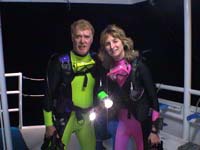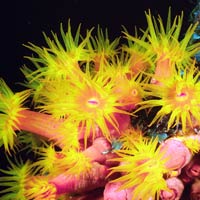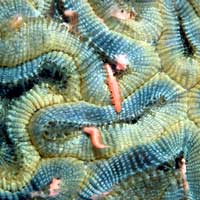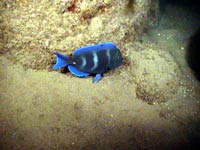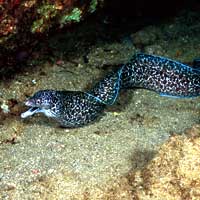
We’re spending the night at a calm spot called Bedroom Bay. We think the area got its name because yachts like to anchor here to sleep at night. The sea is choppy, but not as rough as it’s been. Even though it’s dark now, our diving continues, because we’re going to make a night dive! We wear the same scuba diving equipment we use during the daytime. We’re also using special underwater diving lights. Jumping into the water, we discover that the temperature is the same as during the day – a warm 78 degrees F. Descending underwater, everything around us is black. Our dive lights make beams of light, but shine on nothing. The only things we can see are the lights of the ship shining down into the water above us. We swim down to 60 feet underwater and our dive lights reveal the coral reef at night. During the day colors are filtered out by the water as we dive deeper underwater. Below 50 feet underwater, everything usually looks kind of blue-green. Now we see lots of bright colors on the reef because our dive lights are shining close to the reefs. The lights reveal the colors that are always there, but can’t be seen unless you have a light. Here’s another surprise: at night the corals look fuzzy! During the day, the tiny coral polyps ("paul-ups") are sleeping. Even though they’re sleeping, they get food from sunlight made by the plant cells, which are called zoothanthalee ("zoh-than-thell-ee"). These cells live under the corals’ skin. At night, the corals wake up and reach their tiny sea anemone-like tentacles out into the sea to catch tiny floating animals called plankton. Coral polyps have tiny stingers on their tentacles, like jellyfish, called nematocysts ("new-mat-oh-cists"). These stingers paralyze the plankton that the polyps catch and eat. The corals look fuzzy because thousands of coral polyps have their tentacles sticking out. Do fish sleep? Yes, they do! As we swim across the fuzzy coral reef, we find that some of the fish we saw swimming around during the day are between the corals sleeping. We see a blue tang resting at the bottom of the reef, but it looks different than before. During the daytime, blue tangs are dark blue with lighter blue fins. At night, this blue tang has white stripes. Many fish change color when they go to sleep. It’s as if the fish put on pajamas when they go to bed! Sleeping fish are in danger because some of the fish that were hiding during the day are out at night looking for sleeping fish to eat! We see a moray eel (a fish, not a snake) slithering across the reef looking for sleeping prey. Moray eels can’t see in the dark, but they have an excellent sense of smell. They swim between the corals and when they bump into something that smells like a fish, they bite it before it can get away. We’ve been underwater for about almost an hour. Now it’s time for us to swim back to the boat, take a hot shower and go to bed. As we fall asleep we’re happy that animals don’t slink around at night, looking for sleeping people to eat! |
Wayne and Karen are ready to make a night dive!
Our diving lights shine on bright orange-yellow cup corals, which are reaching out their tiny tentacles at night to catch plankton floating by.
We see brain coral polyps eating tiny orange planktonic worms they’ve caught. Tiny stingers on their tentacles help polyps paralyze and catch their food.
We find a blue tang (about the size of your hand) sleeping at the bottom of the reef at night. Notice the white stripes. He has these only when sleeping.
We see a spotted moray eel (about 2 1/2 feet long) swimming around the reef trying to find sleeping fish to eat for dinner. |
|||||||||||||||||||||
|
||||||
